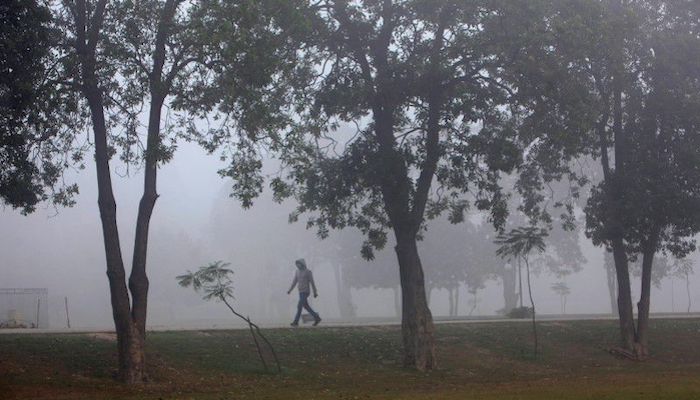The UN’s climate ‘code red’ and what it means for Pakistan
Climate report puts Pakistan in a more challenging situation than ever before
August 16, 2021

The UN’s ‘Intergovernmental Panel on Climate Change’ (IPCC) has launched its Sixth Assessment Report (AR6), with the aim to provide a comprehensive assessment of the physical science of climate change.
The IPCC had previously published five assessment reports, the last (AR5) in 2013-14, with continuous improvement in analysis, evidence, reanalysis and projections.
The current report – AR6 – is perceived to be the cornerstone of climate science for the years ahead, as it provides greater confidence, owing to improvement in observational capacities and developments in the latest generation CMIP6 climate and Earth system models, leading to better understanding and consistency between climate drivers and all the physical, chemical and biological processes of the earth system.
Compared to AR5, the model simulations of CMIP6 used in AR6 used a new set of scenarios, derived from the Shared Socio-economic Pathways (SSPs) which incorporated the element of socio-economic development in emission pathways as well. The report explicitly says that the human influence on the planet is ‘unequivocal’ and has caused ‘widespread and rapid’ changes in all the natural components of the planet.
It has been observed that the evidence about human influence over earth systems has strengthened progressively since AR5, mainly attributed to human induced greenhouse gases emissions leading to warmer climates. With the improvements in observations and reanalysis, the report shows an alarming warming of 1.09 C in 2011-2020, compared to pre-industrial level 1850-1900 with every year warmer than the prior one during 2016-2020.
The ‘bad news’ in the report is that the changes are likely to exacerbate in the future with grander impacts. Previously, the IPCC in its Special Report on 1.5 C warming indicated that the global 1.5 C threshold is likely to be reached between 2030 and 2050. However, in AR6 it reports that the limit is likely to reach in the early 2030s, keeping in view the higher emission rates and enhanced warming over the last decade. This earlier emergence of the 1.5 C threshold has also been indicated by a recent study conducted at the GCISC which has shown that the threshold is likely to reach Pakistan earlier than the global emergence time, indicating the higher vulnerability of Pakistan to the adverse impacts of the changing climate.
The report says that the increased warming trend has affected all the other components, due to which the global precipitation pattern has also been observed to have altered in previous years. This has led to a disparity in precipitation, with some regions receiving precipitation greater than normal while others having faced dry conditions. Focusing particularly on South Asia, it has been revealed that the South Asian monsoon has weakened in the second half of the 20th century, which is attributed primarily to anthropogenic aerosol forcing.
However, the CMIP6 datasets project that both annual as well as summer monsoon precipitation will increase during the 21st century, with enhanced interannual variability. Also, the Himalayan region and Tibetan Plateau is projected to experience wetter conditions during the 21st century.
All these variations are attributed to changes in the water cycle due to intensified warming in the climate system which affect the water holding capacity of the atmosphere and lead to extreme precipitation, flooding and droughts.
Moreover, it warns that dangerous heat stress thresholds will be crossed more often across much of Asia – especially in the south. Pakistan has already been experiencing recurring heatwaves and an increase in frequency over the region as indicated by the IPCC is likely to pose enhanced risk to the country, threatening the wellbeing of the population.
The assessment has also found an augmented warming of oceans and subsequent rise in sea level which, to a greater extent, has done ‘irreversible damage’ to earth systems. It has also been revealed that the Indian Ocean is warming at a faster rate which will have severe consequences to the adjoining landmasses in terms of coastal flooding in low-lying areas of South Asian regions.
The amplified warming of the Indian Ocean has potential consequences over Pakistan in terms of impact over precipitation patterns, causing flooding.
Additionally, the increase in monsoon extremes in the region is also found to be associated with increased droughts in the second half of the 21st century since heavy precipitation will be followed by prolonged dry spells in the region. Such heavy precipitation events are also projected to increase over Hindu-Kush Himalayan, bearing the potential to cause flood related disasters in downstream areas.
Moreover, flooding is likely to exacerbate due to shrinking glaciers pertaining to amplified warming. Snow-cover will reduce and the snow line will be elevated. Due to shrinking glacial and snow cover, water availability in Pakistan is likely to be impacted to a larger extent by the end of the century. Additionally, the phenomenon of Elevation Dependent Warming has the potential to further worsen the melting over snowclad HKH Mountains.
All the assessments and projections highlighted in the report warn of a ‘Red Code’ for humanity showing that robust efforts in reducing GHG emissions to net zero level by mid-century have become unavoidable to prevent irreversible damages to the climate system; this requires dedication at the national, regional and global level.
While Pakistan is already amongst the top ten most affected countries to climate change, these latest findings highlight a greater risk to the country at all levels associated with intensified warming viz changing monsoon precipitation, increasing frequency and intensity of heatwaves and droughts, extreme precipitation events and rising sea level.
Given the most affected and vulnerable country, the report intensifies the threats putting Pakistan in a more challenging situation than ever for concerted and swift actions to mitigate climate change and build resilience. It also calls for the need to enhance scientific research over the country to dispense support to policymakers in decision-making ,and also to provide country-specific research materials for future assessment reports.
Though Pakistani scientists have contributed to this assessment report, with two lead authors from the GCISC, there is a need to come up with advanced models/ tools developed with finer resolution over the country to get insight into changes at the micro level.
The report explicitly demands global action before it is too late to act.
The writers can be reached at [email protected] and [email protected]
This article originally appeared in the August 16, 2021 edition of daily The News. It can be accessed here.










